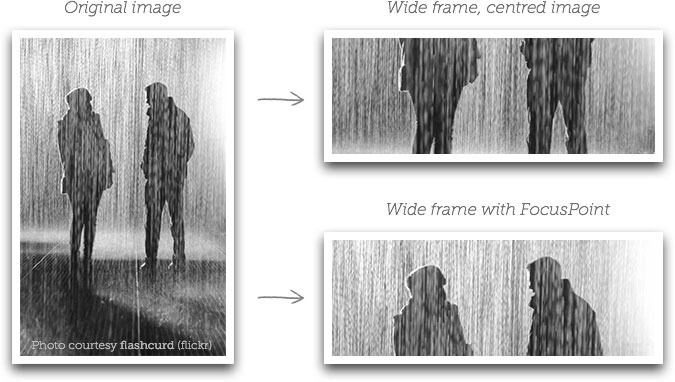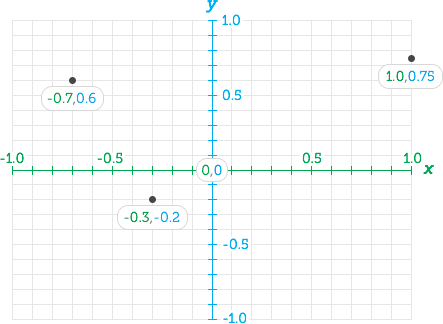jQuery FocusPoint
Intelligent cropping for flexible image containers
Websites don't have a single layout any more. The space you have for an image may be portrait on a laptop, landscape on a tablet, and square on a mobile - particularly if you're using a full-screen image.
If you have to use the same image file in all these contexts, you might not be happy with the results you get when you 'fill' the allocated space with your image. Your subject might be clipped or completely missing, or just really awkward looking.
FocusPoint makes sure your image looks great in any container, by ensuring the 'spare' parts of your image (negative space) are cropped out before the important parts.
Examples
Here are some examples showing the same image cropped a variety of different ways at once. Make sure you play with resizing the browser window to get a feel for what FocusPoint does.
And here is a full screen demo.
How's it work?
The idea is that most images have a focal point or subject that is the most important part of the image. In the case of a traditional portrait photo this would be the subject's face (or specifically the spot right between their eyes). In the image above it's arguably the point halfway between the two people's faces.
FocusPoint requires you to indicate where this focal point is located within your image, and then works in the background to ensure that point is never cropped out.
How to use
1. Calculate your image's focus point
An image's focus point is made up of x (horizontal) and y (vertical) coordinates. The value of a coordinate can be a number with decimal points anywhere between -1 and +1, where 0 is the centre. X:-1 indicates the left edge of the image, x:1 the right edge. For the y axis, y:1 is the top edge and y:-1 is the bottom.
Confused? Don't worry, I've included a handy script to help you find the focus coordinates of an image with a single click. See an example here.
2. Include javascript and CSS
You'll need to include jQuery, the FocusPoint script, and FocusPoint css file. Example:
<link rel="stylesheet" href="focuspoint.css">
<script src="jquery.js"></script>
<script src="focuspoint.js"></script>
3. Mark up image container
Specify the image dimensions and focus point coordinates on the image container. Note: I know it shouldn't really be necessary to specify image dimensions but I've found this to be more reliable than reading the dimensions from the image. Example:
<div class="focuspoint"
data-focus-x="0.331"
data-focus-y="-0.224"
data-image-w="400"
data-image-h="300">
<img src="image.jpg" alt="" />
</div>
4. Fire FocusPoint plugin
Usually the best place for this will be inside your $(document).ready() function.
//Fire plugin
$('.focuspoint').focusPoint();
There aren't many configuration options available at the moment, but if you want to you can prevent images being re-focused when the window is resized like so:
$('.focuspoint').focusPoint({
reCalcOnWindowResize : false
});
You can re-focus images at any time with adjustFocus(). This recalculates where the image should be positioned in the frame. An example where you may need to do this is if you are using FocusPoint images within a slider. FocusPoint can't do it's calculations properly if an image container is hidden (as it won't have any dimensions), so you should trigger adjustFocus() on the target container as soon as it becomes visible. Example:
$('.focuspoint').adjustFocus()
Tips & Tricks
Image composition
In order for this concept of 'fluid cropping' to work well, your images will need to include some negative space around the subject that you are happy to be cropped out when necessary. You don't need space on every side of the subject - but for maximum flexibility you'll want to include both some vertical and horizontal negative space.
Pure CSS alternative
You can get a similar effect to this technique using only CSS and the background-position and background-size properties. Browser support isn't as good (at the moment) and your image won't be positioned exactly the same way - but it's pretty close. The CSS technique leans towards preserving the original composition while FocusPoint is biased towards keeping the subject of the image in the centre of the frame. Depending on your requirements either technique may suit you better.
Pure CSS Example and comparison
SilverStripe CMS integration
This plugin plays really well with the silverstripe-focuspoint module, which lets you set the focuspoint on any image with just a click, and makes the info available in your front-end templates so you don't have to do any math. It also provides really easy 'destructive' cropping outputting resampled images cropped to a particular width and height based on the same logic.
Feedback welcome!
Nothing would encourage me to keep updating this script more than hearing how it's been used in the real world. Get in touch with me at jonathonmenz.com to let me know how you've used this plugin or any suggestions you have for improving it. Please report bugs or issues on github.
Feeling generous?
If FocusPoint helped you impress a client and you want to say thanks, you're welcome to leave a small donation to help fund the purchase of coffee, which will help facilitate future development. But that is totally optional.

